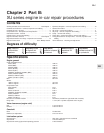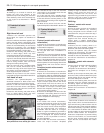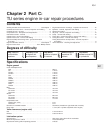
21 Fit a new camshaft oil seal, using the
information given in Section 6, then refit the
sprocket rear cover plate. Align the cover
plate using a 10 mm dowel or drill bit then
secure with the retaining bolt (see
illustration).
22 Refit the camshaft sprocket as described
in Section 5.
23 Check the valve clearances as described
in Section 2.
24 Refit the camshaft cover, HT leads and
distributor cap, air cleaner, and brake servo
vacuum hose.
25 Reconnect the battery negative terminal.
8 Cylinder head - removal and
refitting
4
Removal
1 Drain the cooling system as described in
Chapter 1.
2 Remove the timing belt as described in
Section 4.
3 Slacken, but do not remove, the engine
lower mounting rubber centre nut and bolt
(see illustration).
4 Remove the air cleaner assembly, inlet
ducts and pipes with reference to the relevant
Part of Chapter 4.
5 Remove the crankcase breather and its
pipes.
6 Remove the nut which secures the engine
right-hand mounting rubber to the cylinder
head bracket (see illustration).
7 Carefully raise the engine 60 to 80 mm
using a hoist or a well-protected jack. Remove
the two bolts which secure the right-hand
mounting bracket to the cylinder head, then
lower the engine back into position.
8 Remove the inlet manifold and associated
fuel system components with reference to the
relevant Part of Chapter 4.
9 Make suitable notes as an aid to refitting
then disconnect all coolant and vacuum
hoses and electrical leads from the cylinder
head.
10 Disconnect the exhaust downpipe(s) at
the manifold flange.
11 Remove the coolant pipe from the pump
inlet housing. Also remove the diagnostic
socket from its bracket.
12 Remove the camshaft cover, at the same
time removing the distributor cap and HT
leads. If the cylinder head is to be dismantled
for overhaul, remove the distributor or, on
models with static distributorless ignition
systems, the ignition module, as described in
Chapter 5B.
13 Working in the reverse of the sequence
shown in illustration 8.27, progressively
slacken the cylinder head bolts by half a turn
at a time, until all bolts can be unscrewed by
hand. Remove the bolts along with their
washers, noting the correct location of the
spacer fitted to the front right-hand bolt.
14 With all the cylinder head bolts removed,
the joint between the cylinder head and
gasket and the cylinder block/crankcase must
now be broken without disturbing the wet
liners. Although these liners are better-located
and sealed than some wet-liner engines, there
is still a risk of coolant and foreign matter
leaking into the sump if the cylinder head is
lifted carelessly. If care is not taken and the
liners are moved, there is also a possibility of
the bottom seals being disturbed, causing
leakage after refitting the head.
15 To break the joint, obtain two L-shaped
metal bars which fit into the cylinder head bolt
holes, and gently “rock” the cylinder head free
towards the front of the car. Do not try to
swivel the head on the cylinder
block/crankcase; it is located by dowels, as
well as by the tops of the liners.
16 When the joint is broken, lift the cylinder
head away. Remove the gasket from the top
of the block, noting the two locating dowels. If
the locating dowels are a loose fit, remove
them and store them with the head for safe-
keeping.
17 Do not attempt to turn the crankshaft with
the cylinder head removed, otherwise the wet
liners may be displaced. Operations that
require the crankshaft to be turned (eg
cleaning the piston crowns), should only be
carried out once the cylinder liners are firmly
clamped in position. In the absence of the
special Peugeot liner clamps, the liners can
be clamped in position as follows. Use large
flat washers positioned underneath suitable-
length bolts, or temporarily refit the original
head bolts, with suitable spacers fitted to their
shanks (see illustration).
18 If the cylinder head is to be dismantled for
overhaul, remove the camshaft and cam
followers as described in Section 7, then refer
to Part D of this Chapter.
Preparation for refitting
19 The mating faces of the cylinder head and
cylinder block/crankcase must be perfectly
clean before refitting the head. Use a hard
plastic or wood scraper to remove all traces of
gasket and carbon; also clean the piston
crowns. Refer to paragraph 17 before turning
the crankshaft. Take particular care during the
cleaning operations, as aluminium alloy is
easily damaged. Also, make sure that the
carbon is not allowed to enter the oil and
water passages - this is particularly important
for the lubrication system, as carbon could
block the oil supply to the engine’s
components. Using adhesive tape and paper,
seal the water, oil and bolt holes in the
cylinder block/crankcase. To prevent carbon
entering the gap between the pistons and
bores, smear a little grease in the gap. After
cleaning each piston, use a small brush to
remove all traces of grease and carbon from
the gap, then wipe away the remainder with a
clean rag. Clean all the pistons in the same
way.
20 Check the mating surfaces of the cylinder
block/crankcase and the cylinder head for
nicks, deep scratches and other damage. If
slight, they may be removed carefully with a
file, but if excessive, machining may be the
only alternative to renewal.
2B•8 XU series engine in-car repair procedures
7.21 Align the camshaft sprocket cover
plate using a dowel or twist drill
8.3 Engine lower mounting 8.6 Right-hand engine mounting and
cylinder head bracket
8.17 Cylinder liners clamped with washers
and bolts


















